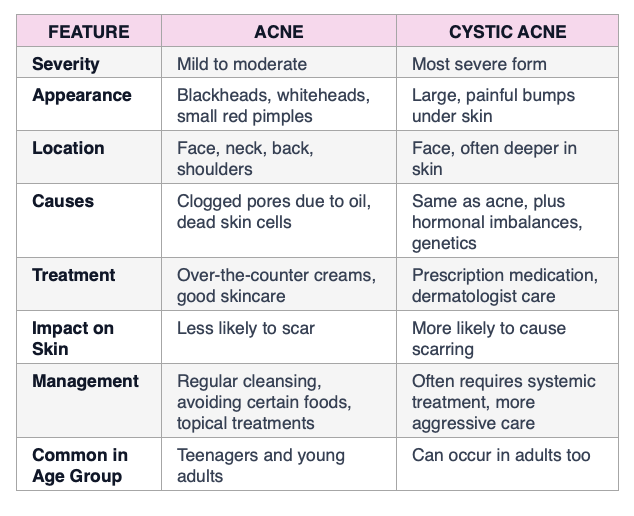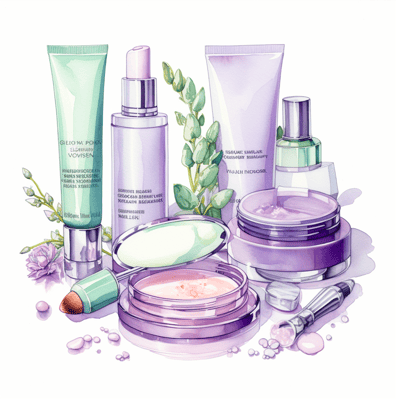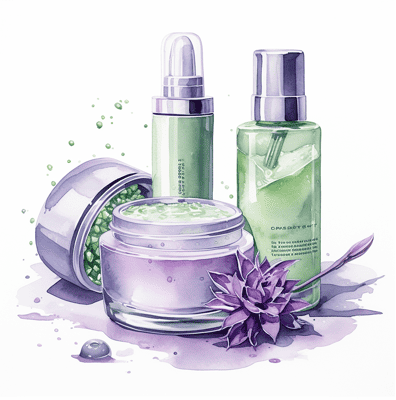
Don’t want to read the whole post?
To distinguish between acne and cystic acne, it’s important to know that cystic acne is a severe form with large, painful bumps under the skin, often requiring professional treatment. Regular acne, less severe, includes blackheads and whiteheads, and can often be managed with over-the-counter products.
ABOUT ME
Be beauty. Be plant-based!
As a former Registered Nurse and avid plant-muncher, I’m in love with how simple plant-based foods make it easy to be beautiful.

You’ll also love:
Beyond Breakouts: How to Be Confident With Acne
Acne, a term that conjures up images of teenage years filled with skin woes, is actually a more complex condition than many realise. For health-conscious women striving for both inner and outer beauty, understanding the nuances between regular acne and its more severe counterpart, cystic acne, is crucial. This exploration into acne vs. cystic acne not only addresses common misconceptions but also offers insight into effective management and treatment options that align with a lifestyle aiming for wellness and attractiveness.
What is Acne?
Acne vulgaris, commonly just called acne, is a skin condition that affects most people at some point in their lives.
It’s characterised by clogged pores which occur in hair follicles and sebaceous glands. These blockages are often caused by a buildup of dead skin cells and oily skin, leading to the formation of pimples, blackheads, or whiteheads on the skin’s surface.

There are different types of acne, ranging from mild acne, which includes non-inflammatory lesions like blackheads and whiteheads, to moderate acne, characterised by inflamed pimples and pustules.
In all cases, the key culprits behind these skin blemishes are excess oil production and a mix of other factors, including hormonal changes and external environmental triggers. Understanding these basics is the first step towards achieving clear skin and managing painful breakouts effectively.
What is Cystic Acne?
Cystic acne stands as the most severe form of acne, presenting a far more challenging scenario than typical acne.
This type of acne forms deep, painful breakouts beneath the skin, manifesting as nodulocystic acne, a mix of both nodular acne and cystic pimples. These are not just surface-level issues; they’re rooted deeply in the skin’s layers, often leading to significant discomfort.
You’ll also love:
Pimple Alert: Does the Sun Help Acne?
The causes of cystic acne are multifaceted. Like regular acne, it involves blocked pores and excess oil production. However, it’s further complicated by factors like hormonal imbalances, which can lead to hormonal cystic acne, and genetic predispositions. These elements combine to create an inflammatory response, resulting in large, red, and painful bumps under the skin, a stark contrast to the smaller blemishes seen in milder acne forms.
Acne vs Cystic Acne
The primary distinction between regular acne and cystic acne lies in their appearance and severity. While regular acne might present as blackheads or small red pimples on the skin’s surface, cystic acne delves deeper. It forms large, painful bumps that lurk under the skin, often leading to severe cystic acne cases. These can be significantly more painful and long-lasting than typical acne lesions.

Moreover, cystic acne tends to be more resistant to standard treatments. This resistance highlights the need for specialised approaches for treatment of cystic acne, such as stronger prescription medication.
In comparison, regular acne can often be managed with over-the-counter treatments and good skincare practices. The persistence and intensity of cystic acne not only impact the skin but can also affect an individual’s self-esteem, making it a more troublesome variant of this common skin condition.

You’ll also love:
Herbs for Hormonal Acne: Transform Your Skin
Managing Acne and Cystic Acne
Effective management of both acne and cystic acne is pivotal for maintaining healthy skin. The key is to minimise factors that exacerbate the conditions, like excess oil production and hormonal changes. A good skincare routine, including using gentle cleansers and avoiding harsh products, helps in keeping the surface of the skin clear and reduces the chances of painful breakouts. For those with oily skin, selecting products that control oil without over-drying is essential.

Diet also plays a significant role in managing these skin conditions. A plant-based diet, low in sugar and dairy, can contribute to clear skin by potentially reducing inflammation and regulating hormone levels. Additionally, managing stress and getting adequate sleep are crucial for hormonal balance, which in turn can positively impact skin health.
Revitalising Your Skin with a Plant-Packed Diet!
Imagine starting your day with a warm bowl of creamy steel-cut oats, topped with a burst of sweet berries and crunchy nuts – a breakfast that wakes up your skin as much as it does your senses. For lunch, picture a colourful bean salad, vibrant with crisp greens, juicy tomatoes, and a zesty dressing, nourishing your body and combating acne with every delicious bite.

Snack on succulent fruits, a sweet treat that’s also a secret weapon against breakouts with their colourful antioxidants. Dinner could be a culinary masterpiece of mixed vegetables, stir-fried to perfection with aromatic herbs and spices, alongside a hearty bean stew that reduces blood sugar levels and hormonal imbalance. Each meal is not just a feast for your taste buds but also a step towards clearer, more radiant skin!
Eating these foods in various combinations ensures that each meal is a delightful, skin-friendly experience. Enjoy the journey to healthier skin with every scrumptious, plant-based meal!
Treatment Options
The treatment options for acne and cystic acne vary based on the severity and type of acne.
Topical acne medications, like benzoyl peroxide and salicylic acid, are often effective in treating mild to moderate acne. These treatments work by reducing inflammation and unclogging pores. For more persistent or severe acne, topical retinoids may be prescribed, which help in cell turnover and prevent the clogging of pores.

Cystic acne, being more severe, might require oral antibiotics to reduce bacteria and inflammation or prescription medication specifically formulated for severe cases. In women, birth control pills can be an option to manage hormonal cystic acne by regulating hormone levels. It’s important to understand the side effects of these treatments and consult a dermatologist to determine the best course of action.
Advanced Treatments
For those facing more severe cases of acne, especially cystic acne, advanced treatments become necessary. One of the most effective treatments for severe acne is Isotretinoin, commonly known as Accutane. This medication addresses various factors contributing to acne, such as reducing oil gland activity and preventing clogged pores. Isotretinoin is renowned for its ability to significantly clear acne, even in severe cystic acne cases, but it also comes with a range of side effects that must be carefully considered under medical supervision.
Another advanced option for treating stubborn acne includes chemical peels. These peels help in exfoliating the surface of the skin, removing dead skin cells, and unclogging pores, thereby reducing the appearance of acne. It’s essential for individuals to consult with dermatologists to understand the most suitable peel type and frequency for their specific skin condition.
Conclusion: Acne vs Cystic Acne
In conclusion, understanding the differences between acne vs. cystic acne is vital for anyone seeking to manage these skin conditions effectively. While both share common origins, such as excess oil production and hormonal changes, their treatment and management strategies differ significantly. Regular acne can often be managed with over-the-counter treatments and good skincare practices. In contrast, cystic acne, being the most severe form of acne, requires more aggressive and specialised treatment approaches.